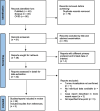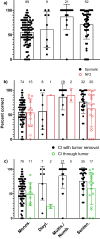Cochlear implantation in patients with inner ear schwannomas: a systematic review and meta-analysis of audiological outcomes
- PMID: 38992191
- PMCID: PMC11564253
- DOI: 10.1007/s00405-024-08818-3
Cochlear implantation in patients with inner ear schwannomas: a systematic review and meta-analysis of audiological outcomes
Abstract
Purpose: In patients with inner ear schwannomas (IES), reports on hearing rehabilitation with cochlear implants (CI) have increased over the past decade, most of which are case reports or small case series. The aim of this study is to systematically review the reported hearing results with CI in patients with IES considering the different audiologic outcome measures used in different countries.
Methods: According to the Preferred Reporting Items for Systematic Reviews and Meta-Analyses (PRISMA) guideline, a search of published literature was conducted. We included patients with IES (primary or with secondary extension from the internal auditory canal (IAC) to the inner ear, sporadic or NF2 related) undergoing cochlear implantation with or without tumour removal. The audiological results were divided into the categories "monosyllables", "disyllables", "multisyllabic words or numbers", and "sentences".
Results: Predefined audiological outcome measures were available from 110 patients and 111 ears in 27 reports. The mean recognition scores for monosyllabic words with CI were 55% (SD: 24), for bisyllabic words 61% (SD: 36), for multisyllabic words and numbers 87% (SD: 25), and 71% (SD: 30) for sentences. Results from for multisyllabic words and numbers in general showed a tendency towards a ceiling effect. Possible risk factors for performance below average were higher complexity tumours (inner ear plus IAC/CPA), NF2, CI without tumour removal ("CI through tumour"), and sequential cochlear implantation after tumour removal (staged surgery).
Conclusion: Hearing loss in patients with inner ear schwannomas can be successfully rehabilitated with CI with above average speech performance in most cases. Cochlear implantation thus represents a valuable option for hearing rehabilitation also in patients with IES while at the same time maintaining the possibility of MRI follow-up. Further studies should investigate possible risk factors for poor performance. Audiological tests and outcome parameters should be reported in detail and ideally be harmonized to allow better comparison between languages.
Keywords: Acoustic neuroma; Cochlear implant; Inner ear schwannoma; Intracochlear; Intralabyrinthine; Neurotology; Schwannoma; Skull base surgery; Vestibular schwannoma.
© 2024. The Author(s).
Conflict of interest statement
Figures




Similar articles
-
The effectiveness and cost-effectiveness of cochlear implants for severe to profound deafness in children and adults: a systematic review and economic model.Health Technol Assess. 2009 Sep;13(44):1-330. doi: 10.3310/hta13440. Health Technol Assess. 2009. PMID: 19799825
-
Hearing Instruments for Unilateral Severe-to-Profound Sensorineural Hearing Loss in Adults: A Systematic Review and Meta-Analysis.Ear Hear. 2016 Sep-Oct;37(5):495-507. doi: 10.1097/AUD.0000000000000313. Ear Hear. 2016. PMID: 27232073 Free PMC article.
-
Primary culture of inner ear schwannoma.J Neurosci Methods. 2025 Oct;422:110515. doi: 10.1016/j.jneumeth.2025.110515. Epub 2025 Jun 17. J Neurosci Methods. 2025. PMID: 40553914
-
Cochlear Implantation in Inner Ear Malformations: Systematic Review of Speech Perception Outcomes and Intraoperative Findings.Otolaryngol Head Neck Surg. 2017 May;156(5):783-793. doi: 10.1177/0194599817696502. Epub 2017 Apr 4. Otolaryngol Head Neck Surg. 2017. PMID: 28374626
-
Comparing Speech Recognition Outcomes Between Cochlear Implants and Auditory Brainstem Implants in Patients With NF2-Related Schwannomatosis.Otol Neurotol. 2024 Jan 1;45(1):29-35. doi: 10.1097/MAO.0000000000004047. Epub 2023 Oct 24. Otol Neurotol. 2024. PMID: 37875011
Cited by
-
Surgical Transcanal Procedure for Injection of Cells and Substances into the Human Cochlear Modiolus.Otol Neurotol. 2025 Apr 1;46(4):476-484. doi: 10.1097/MAO.0000000000004463. Epub 2025 Feb 20. Otol Neurotol. 2025. PMID: 39972988 Free PMC article.
-
[Inner ear schwannomas and hearing rehabilitation with cochlear implants-an update].HNO. 2025 Aug;73(8):547-549. doi: 10.1007/s00106-025-01639-8. Epub 2025 May 22. HNO. 2025. PMID: 40402241 German. No abstract available.
References
-
- Kennedy RJ, Shelton C, Salzman KL et al (2004) Intralabyrinthine schwannomas: diagnosis, management, and a new classification system. Otol Neurotol 25:160–167. 10.1097/00129492-200403000-00014 - PubMed
-
- Dubernard X, Somers T, Veros K et al (2014) Clinical presentation of intralabyrinthine schwannomas: a multicenter study of 110 cases. Otol Neurotol. 10.1097/MAO.0000000000000415 - PubMed
-
- Van Abel KM, Carlson ML, Link MJ et al (2013) Primary inner ear schwannomas: a case series and systematic review of the literature. Laryngoscope 123:1957–1966. 10.1002/lary.23928 - PubMed
Publication types
MeSH terms
LinkOut - more resources
Full Text Sources
Miscellaneous

